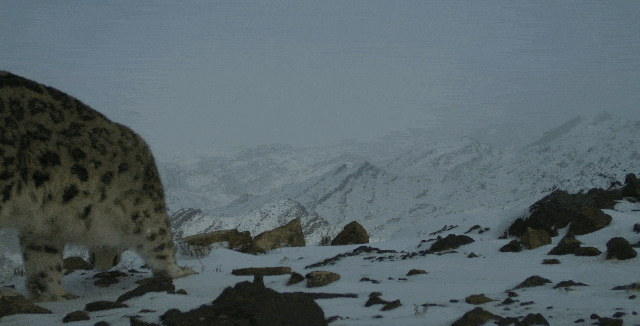Before this study, the genomes of only four snow leopards had been sequenced. This study brought that number up to 41, contributing a massive increase in our understanding of snow leopard genetics. Our team provided crucial support by sourcing samples for the Stanford scientists to sequence. Their findings tell an interesting story about the ancestry of snow leopards.
Significantly, they found that snow leopards have the lowest genetic diversity among all big cat species, including cheetahs, which are well-known for their low genetic diversity. This is likely due to a persistently low, but stable, population size throughout their evolutionary history. Other species with low levels of genetic diversity often also have high rates of inbreeding, but researchers didn’t find evidence of this among snow leopards. This may be explained by a high level of connectivity between snow leopard populations, and because these intrepid cats have a penchant for traveling long distances between mountain ranges. Perhaps curiosity saved the cat?

It’s impossible to know exactly how many snow leopards roamed Earth’s high peaks in the past, but this research suggests that their population has been consistently low during the last 900,000 years and then experienced a bottleneck about 20,000 to 30,000 years ago during the height of the last glaciation. But it seems even this apparent bottleneck, which may have halved their population, did not have a major impact on their genetic diversity, which is common after such occurrences.
All that was a long, long time ago. So what does it have to do with snow leopards today? While it’s reassuring that snow leopards don’t show high rates of inbreeding, a small population coupled with low genetic diversity means the species may be less able to adapt in a fast-changing world.
This is especially concerning, given that their habitat is already experiencing significant human-caused climate change and the growth of industry and development in their once inaccessible mountains. This remoteness was probably what kept the species secure despite its small population over millennia; the cats were able to endure because they were more removed from the pressures that humans have historically always put on predators.
That is no longer the reality, and conservation approaches will need to adapt if and when the snow leopard can’t. Our teams are working to address this growing threat in partnership with the Indigenous Peoples and local communities sharing these precarious mountains. Through livelihood adaptation programs, livestock care and management, and ethical research, we are fostering coexistence with snow leopards and securing their future.
This groundbreaking work with Stanford opens new possibilities for our long-term research study of snow leopards. We’re continuing our collaboration to gather more samples that will help us understand the genetic structure of snow leopard populations and identify potential barriers to gene flow across their range.
One exciting possibility is using landscape genetics to map connectivity and animal movement across vast areas. This approach could reveal which landscape features act as barriers and which serve as dispersal corridors for snow leopards. While GPS collars are excellent for tracking individual movements, and cameras can show us movement between monitored sites, genetics may be the only tool that allows us to understand connectivity at large spatial scales.
Sign up for our monthly E-News to get all the latest updates from the field delivered to your inbox.
Read the full paper here.
Photo credits: Ali Javed, SLCF-Mongolia
Acknowledgments: Thank you to Stanford University, Bronx Zoo and all other contributors. Special thanks to Zoo New England for their continued support of this snow leopard genetics study.

